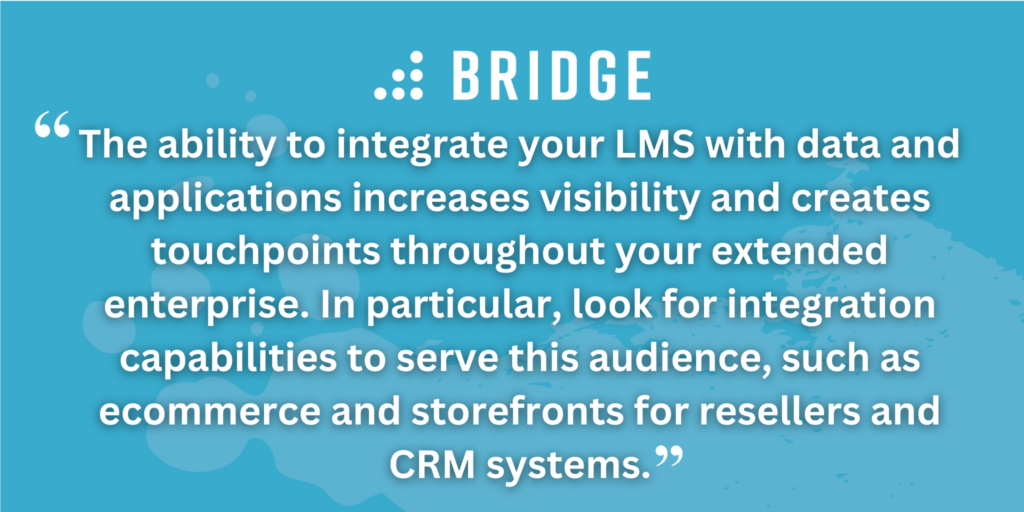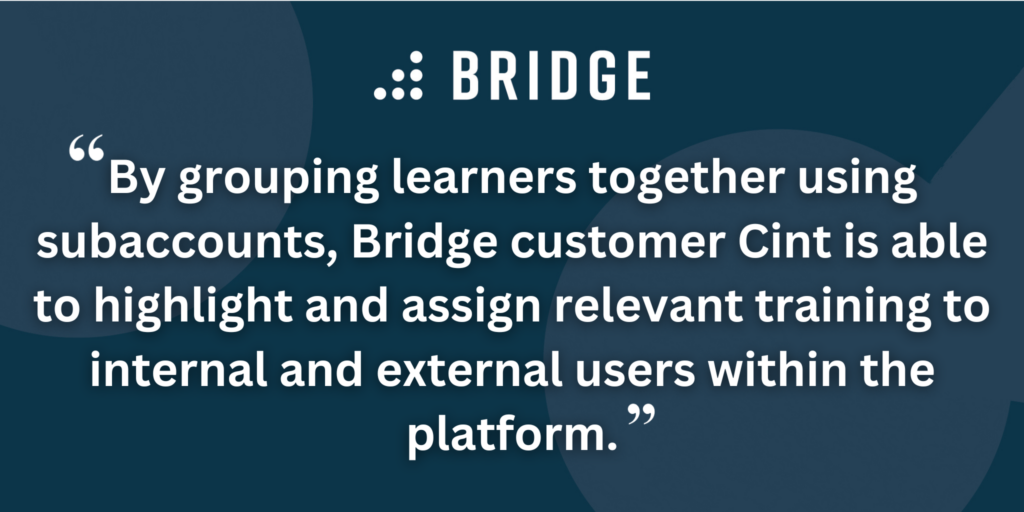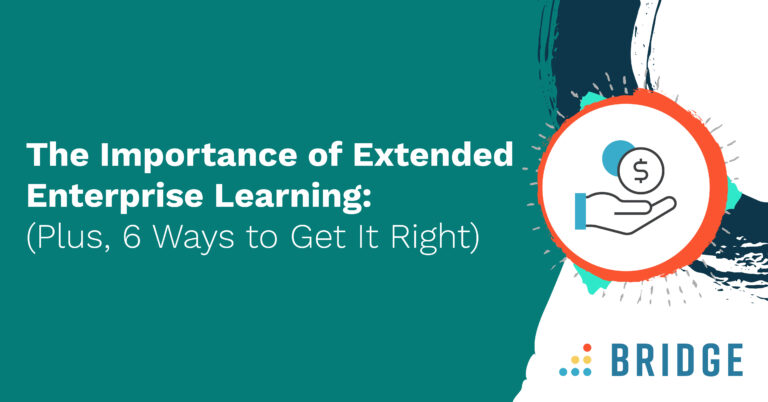It’s no secret that learning and upskilling improves organizational performance. But to further boost revenue and increase growth, this training must extend beyond the boundaries of your internal workforce through extended enterprise learning.
Read on to discover the importance of training your extended enterprise and how to target and track your L&D programs.
The Benefits of Extended Enterprise Learning
Your training and development programs aren't just for internal employees—it’s important to remember your suppliers, partners, distributors, and even customers. One way is via extended enterprise learning, a powerful but sometimes untapped tool that offers several opportunities.
1) The Need to Centralize Knowledge Among an Increasingly Dispersed Workforce
According to Deloitte, 81% of executives say that work is increasingly performed across functions and boundaries within their businesses. As a result, training must encompass employees as well as external entities.
An extended enterprise strategy allows you to define and segment your audiences, oversee skills requirements, and tailor training to meet these needs. As another Deloitte study highlights, those who see their workforce as boundaryless and proactively identify training and upskilling requirements among both internal and external workers are 1.6 times more likely to achieve their desired business outcomes.
2) Improving Extended Enterprise Product Knowledge Leads to Revenue Generation
Salesforce report findings show that 84% of business buyers expect sales reps to act as trusted advisors. However, over half also say they've had an inconsistent buying experience that makes them feel like they're dealing with a different company.
High levels of competency and knowledge lead to the best customer experiences. But without the same access to information or level of training across your workforce, there's a risk of missing key messaging or conveying different value propositions to customers. With greater knowledge of your values and offerings, your extended enterprise can better represent and advocate for your organization.
Centralizing your product and brand messaging into a single, accessible place gives you control over this information, making it consistent and clear. With a well-crafted extended enterprise learning strategy, you give your distributed network easy-to-reference and up-to-date access to product, brand knowledge, and technical requirements.
3) A Growing Customer Demand for Training
Providing training and self-serve resources can improve the customer experience and reduce the reliance on customer support. This learning can directly influence lead generation and sales, driving revenue and reducing post-sale troubleshooting and friction.
According to one study, when customers have access to training content, including product demos and training videos, an organization is 58% more likely to exceed performance goals and retain its customers.

The 4 Main Components of an Extended Enterprise Learning Strategy
For your training to be most effective, it must resonate with your audience and their challenges. Keep the following in mind when developing your strategy.

1) Your Learners
Extended enterprise learning is all about providing training and resources to groups outside your internal workforce that are critical to your business operations.
You need to know who these groups are and their relationship to your product or service, as this will determine your training.
Extended enterprise training usually involves some of the following:
- Partners, including your resellers, affiliates, and service providers, who promote and sell your products or services
- Vendors that produce and supply your products or services
- Franchisees that operate under your organization’s brand
- Customers and end-users who need to know how to use your products or services
- Contingent workers and contractors outside your organization’s payroll
2) Key Performance Indicators (KPIs)
Measuring the effectiveness of your training programs isn't always straightforward in a decentralized environment.
To measure the business impact, you'll need to understand the problem you want to solve, as this can help you validate your external enterprise performance metrics. Connecting these metrics to your training and development programs can help you track improvements and show the ROI.
Some examples to demonstrate the value of training might include:
- Increasing sales by giving partners and resellers up-to-date, in-depth product information
- Reducing the number of support tickets by rolling out customer training
- Saving time and making processes more efficient among vendors
READ MORE ABOUT L&D METRICS | ‘How to Prove the ROI of Learning & Development: Unlocking the Metrics That Matter’
3) Content Development and Distribution
There's no need to start from scratch when creating content for your extended enterprise. Instead, consider reusing and amending existing content based on your audiences’ unique needs. Always be mindful of your audience and their goals, keep training relevant, and consider language and cultural differences.
Remember that training isn't one-and-done. In fast-changing and compliance-heavy environments, you'll want a way to continuously update and roll out your content to learners.
4) Learning Technology
Your learning tech is at the heart of your L&D strategies, and according to a Bridge-sponsored report, 83% of HR and L&D professionals say that their LMS plays a critical role in their organization’s L&D strategy.
An LMS that accommodates external customer and partner training must support users across a wide range of locations, giving them a central place to access training on any device.
Furthermore, your learning platform should bring your learning, performance, and talent development data in one place so you can target skills development and track the results of training.

The 6 LMS Features That Support Your Extended Enterprise
An LMS that’s diverse enough to meet the needs of your internal and external audiences will have some of the following features.

1) Extensive LMS Integrations
Connectivity is key, and you'll need an LMS that links business-critical information from multiple sources.
The ability to integrate your LMS with data and applications increases visibility and creates touchpoints throughout your extended enterprise. In particular, look for integration capabilities to serve this audience, such as ecommerce and storefronts for resellers.
In addition, you can support users by bringing together disparate learning platforms into a single, cohesive environment with APIs, webhooks, and single sign-on (SSO). This enables a consistent branding and user interface, eliminating the need to log into multiple systems to access information.
DISCOVER WHY YOU ONLY NEED ONE TOOL FOR L&D | ‘The Why and How of Strategic L&D Tech Consolidation’
2) Efficient AI-Assisted Content Workflows
You already know that when it comes to training and upskilling, your content isn't one size fits all. Your LMS should be flexible enough to serve multiple needs, while cutting out the work for L&D administrators.
An AI-enabled learning and development platform offers real-time insight into learners' current skills and their required competencies based on job titles. This insight is the foundation for personalizing content creation and distribution, ensuring your learners get the right training resources.
Taking this approach a step further, you can also find existing content within your platform and make it visible to the right audiences based on job titles, skills, or mandatory compliance requirements. Use AI assistance to tag your content with the appropriate skills and expose it to the right audience. This makes it simpler for external learners to search your platform and find a resource at the point of need.
KEEP READING | ‘How to Use AI With Your Learning Management System’
3) In-Depth L&D Reporting and Analytics
You'll need the data to prove the value of training and development efforts. An LMS with reporting and analytics capabilities can help you track learner utilization and knowledge transfer.
When these analytics are supported by skills assessments and knowledge checks, you'll get a clear picture of the training that's delivering its intended results and the learners with the strongest skillsets.
A platform that connects L&D insights to performance metrics and competency levels can help to measure the return on investment of your extended enterprise training programs.

4) Certification and Compliance Management
No industry is free from compliance training and an LMS helps you keep on top of these requirements. Your external learners can be trained and tested to ensure continuous adherence to regulations and policies.
An LMS offers a centralized location for managing compliance enrollments, tracking deadlines, and storing certificates. Beyond this, a compliance-friendly platform can reduce the administrative work by automating enrollments and distributing training to relevant audiences.
5) The Ability to Segment and Target Training
You'll want an LMS that allows you to control and oversee users, employee populations, and content using subaccounts. This way, you can manage permissions and learning items for different customers within your extended enterprise organizations, segment analytics, set dedicated admins, and customize single sign-on rules.
Take Bridge customer Cint, for example, which streamlined its content creation and administration process by leveraging subaccounts. By grouping learners together, Cint is able to assign and highlight relevant training to internal and external users within the platform.
SEE BRIDGE IN ACTION | ‘Self-Guided Tour: Subaccounts’
6) A Dedicated Mobile App
Not everyone is tied to a desk, and if learners are on the go or without an internet connection, they'll still want to access content.
A dedicated mobile app with offline learning capabilities serves dispersed and field workers, giving them the same level of access to your content and keeping them connected. They can complete training, receive notifications, and search for content no matter their location or device.
Accelerate Your Extended Enterprise Learning Strategy With Bridge.
Bridge LMS helps organizations design and deliver learning to its employees, partners, and customers.
Create, catalog, and deliver training at scale with course authoring, automated learning journeys, video hosting, analytics, live training, and a mobile app.




